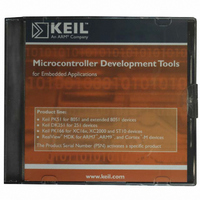MDK-ARM Keil, MDK-ARM Datasheet - Page 49

MDK-ARM
Manufacturer Part Number
MDK-ARM
Description
KIT REALVIEW MCU DEVELOPMENT
Manufacturer
Keil
Type
Compiler and IDEr
Specifications of MDK-ARM
For Use With/related Products
ARM MCUs
Lead Free Status / RoHS Status
Lead free / RoHS Compliant
- Current page: 49 of 156
- Download datasheet (3Mb)
Getting Started: Building Applications with RL-ARM
Chapter 3. RL-Flash Introduction
This chapter discusses configuring and using the RL-Flash embedded file system.
To many experienced developers of small embedded systems, the concept of
using a file system may be considered something of a luxury. However,
technology has moved on, and, as we saw in the first chapter, ARM processor-
based microcontrollers now have the processing power to make using an RTOS
practical. They also have the memory resources to support the use of embedded
file systems. Adding a file system to a small-embedded system allows you to
build applications that are far more complex.
The file system can be used to store program data during deep power saving
modes, or for holding program constants, or even for storing firmware upgrades
for a bootloader. In short, a file system is a new and extremely useful tool for
developers of small, embedded systems.
The RL-Flash file system allows you to place a file system in most common
memory types including SRAM, Parallel Flash, Serial Flash, and SD/MMC
cards. In the case of SD/MMC cards, FAT12, FAT16, and FAT32 are supported.
As we will see in later chapters, the file system can be accessed through the USB
Mass Storage Class and through Ethernet with the Trivial File Transfer Protocol
(TFTP). This provides an easy and well-understood method of accessing your
data. Throughout this chapter, we will first discuss configuring a RAM-based
file system that occupies the internal SRAM of a small microcontroller. Then we
will use this file system to review the ANSI file I/O functions available within
RL-Flash. In the remainder of the chapter, we will discuss configuring the file
system for the remaining memory formats.
Getting Started
In this first section, we will look at configuring the file system to use the internal
RAM of a typical ARM processor-based microcontroller. Although this is not
usually practical in real embedded systems, as all data would be lost once power
is removed from the microcontroller, it does give us an easy starting point with
which to practice our file handling skills.
49
Related parts for MDK-ARM
Image
Part Number
Description
Manufacturer
Datasheet
Request
R

Part Number:
Description:
KIT REALVIEW MCU DEVELOPMENT
Manufacturer:
Keil
Datasheet:

Part Number:
Description:
Development Software SUPPORT EXTENSION FOR MDK-ARM-B
Manufacturer:
Keil Software

Part Number:
Description:
Development Software SUPPORT EXTENSION FOR MDK-ARM
Manufacturer:
Keil Software

Part Number:
Description:
KIT REALVIEW MCU DEVELOPMENT
Manufacturer:
Keil
Datasheet:

Part Number:
Description:
Development Software MCU DEV KIT FOR ARM UPG TO FLOATING LIC
Manufacturer:
Keil Tools

Part Number:
Description:
Development Software MCU DEV KIT FOR ARM W/ FLOATING LICENSE
Manufacturer:
Keil Software

Part Number:
Description:
Development Software MCU DEV KIT FOR ARM uVISION & C++ & RTX
Manufacturer:
Keil Tools

Part Number:
Description:
Development Software SUPP LICENSE RENEWAL 90+ DAYS NO TECH SUP
Manufacturer:
Keil Software
Part Number:
Description:
KEIL C-COMPILER INTERNATIONAL
Manufacturer:
Silicon Laboratories Inc

Part Number:
Description:
BOARD EVAL FOR LPC213X ARM MCU
Manufacturer:
NXP Semiconductors
Datasheet:
Part Number:
Description:
K60N512 Keil Tower Kit
Manufacturer:
Freescale Semiconductor
Datasheet:










